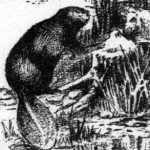Overview
The purpose of this lesson is to provide students with a discussion transition into lessons or units in the economics, history, and ecology of Oregon. These discussions focus on the beaver fur trade and its effect on the beaver population and beaver ecosystems. There are many extension activity ideas that can be implemented from this discussion.
Oregon Common Core State Standards
Language Arts Standards:
- ELA.SL.4.1 Engage effectively in a range of collaborative discussions (one-on-one, in groups, and teacher-led) with diverse partners on grade 4 topics and texts, building on others’ ideas and expressing their own clearly.
Social Studies Standards:
- Historical Knowledge 4.2: Explain how key individuals and events influenced the early growth and changes in Oregon.
- Geography 4.11: Identify conflicts involving the use of land, natural resources, economy, competition for scarce resources, different political views, boundary disputes, and cultural differences within Oregon and between different geographical areas.
Materials
- Historic Oregon Newspapers website
- Copies of newspapers (listed below)
Key Vocabulary
- Beaver
- State symbol
- Decline
- Fur trapping
- Supply
- Demand
Lesson
- Introduction: Each student or group should have a copy of Sunday Oregonian. Point out the front page of the newspaper, focusing on the beaver. Ask students to make observations about the front page.
- Some discussion questions to consider:
- Why do you think beavers made the front page of this newspaper?
- What do you notice about the photographs?
- What do you notice about the time this newspaper was published?
- Why do you think the man is sawing out a piece of the beaver cuttings?
- This newspaper article describes the decline of the beaver population. Why do you think beaver colonies are getting smaller?
- Do you think this is a legitimate photograph? Why?
- Discussion: Introduce the beaver fur advertisements. Discuss the demands of beaver fur during this time.
- Beaver fur advertisements:
- “Absolute Clearance of Furs” from Sunday Oregonian, November 28, 1920
- “Sipman Wolfe’s Starts the Clearing of Ready-to-Wear a Month Ahead of Time” from Morning Oregonian, December 07, 1921
- “August Sale of Furs” from Sunday Oregonian, July 30, 1922
- “Great Rearrangement Sale” from Sunday Oregonian, November 05, 1922
- “January Clearance Sales” from Sunday Oregonian, December 31, 1922
- Some discussion questions to consider:
- What are some things you noticed about these advertisements?
- What was the most interesting thing you saw?
- How do you feel about these advertisements?
Extension Activity Ideas
Activities can be modified several different ways, depending on the grade level and focus of study. Listed are resources that can be adapted and extended to and for any grade level.
- Science Unit: This discussion can lead into a science unit about beavers, both their importance and history in Oregon. Some useful links are listed below.
- Upham Woods: A comprehensive unit about beaver ecology
- National Park Service: A lesson plan about beaver ecosystems
- Social Studies Unit: This discussion can lead into a social studies unit involving some government topics about beavers and their transformation into the state’s symbol, in addition to the history of Oregon becoming “The Beaver State.”
- Enchanted Learning: Background information about the state of Oregon
- Net State: Additional information about the state of Oregon
- Economics Unit: This discussion can lead into an economics unit about the history of beaver fur in Oregon and the decline of the beaver population.
- History Colorado: A lesson plan about fur trappers and beaver pelts
Resources
Background
The first of Oregon’s natural resources to be recognized and extracted by Euro-Americans was fur. In the early decades of the nineteenth century, furs were highly valuable commodities of international trade. Early explorers of the Northwest, such as Robert Gray and Lewis and Clark, reported that the region’s many waterways supported an abundant population of sea otter and beaver. When people back east heard about this, they knew there was the potential for great profits to be made. So, the first permanent Euro-American settlements in Oregon were trading outposts established by large and powerful fur trading companies that were based in London and New York.
Initially, traders in Oregon obtained their furs by bartering with Native Americans. As the enormous value of the Northwest’s fur resources quickly became apparent to them, corporations such as Hudson’s Bay Company and Pacific Fur Company decided to start employing their own workforce, and professional trappers were brought in from Canada, the American states, and islands of the South Seas. The increasing number of trappers and competition between English and American companies quickly began to deplete the populations of the fur-bearing animals. In fact, by 1824, the Hudson’s Bay Company was pursuing a strategy of intentionally “trapping out” and eliminating beaver from entire sections of the Oregon interior in order to keep rival businesses from moving into those areas. In little more than a decade, the beaver had nearly disappeared from what would later come to be known as “The Beaver State.”


Leave a Reply